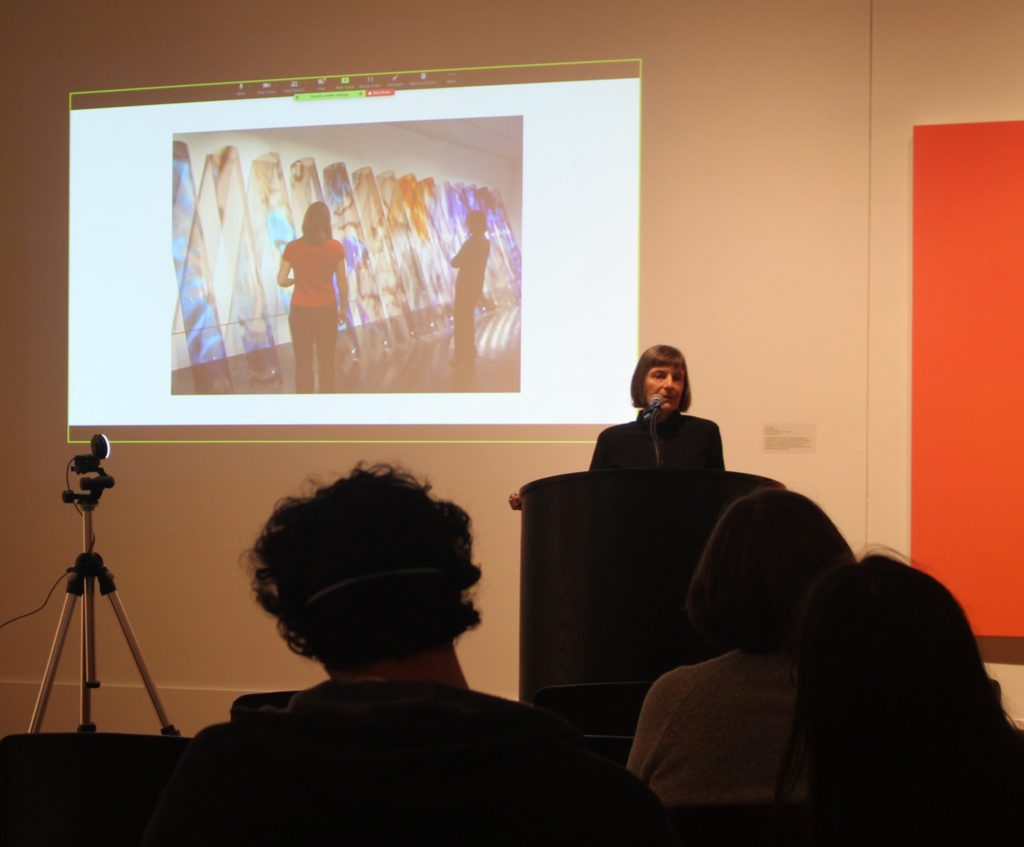Libby Eggert
eggertli@grinnell.edu
Grinnell College Museum of Art’s (GCMoA) current exhibition, “Digital Vision,” showcases works from seven artists who utilize digital components in their work. Among these artists are Jody Zellen and Kate Petley, who spoke in the GCMoA on April 5 to display their pieces and discuss their creative processes that shaped their works in the exhibit.
While both artists employ technology in their art, they do so in very different ways. Zellen makes apps or websites with photographs or her signature single-line figure drawings. Her main piece in the museum is part of an interactive project called “Contextualizing the Unemployed,” involving several screens that show the figures walking back and forth in the rough outline of a country.
Petley’s pieces are photographs printed on larger-than-life canvases. The subjects are everyday objects with carefully orchestrated lighting photographed at a close-up level, distorting the viewer’s recognition of the object.
Zellen joined the event through Zoom from Santa Monica, California. She spoke about her process, usually starting with drawing by hand, often while listening to music.
She said the drawings are a “stream-of-consciousness response and they begin to morph to having figures, and eventually the figures begin to fill the entire page.” She also does collages, creating black silhouettes from magazine pages and “filling around the space with the stream-of-consciousness.”
Zellen started with photography, moved to animation, and then began creating websites. She went to NYU in 2007 to earn an MPS from their Interactive Telecommunications Program to help improve her coding and art skills and to collaborate with engineers and computer scientists.
She finished, “only to realize I had no aptitude for it,” she said. “Really sophisticated engineering should be left to the computer scientists.” “The Unemployed” runs as an app, a website and as a display in the exhibit.
“My hope is that they [viewers] would identify with the figures, which is why I wanted to bring the shape of the figures out of the computer and onto the wall.”
Petley earned a BFA from the University of Utah in Structure and Ceramics and worked as an artist in Houston before moving to Boulder, Colorado. Her career started with large media and installations, namely “site-specific installations in unusual locations.”
The transition to photography came later in her career. After working with photographers on documenting her own art, she said “I found the photograph of them [the subject] to be more compelling than the thing itself.”
“I need to take control of this, and I need to take the pictures myself. That was a big step. I have come a long way and really own that. I’m standing firmly with what it means to make these images.”
Her works in the museum are striking warm colors, bright reds and oranges, sometimes imitating a phone or computer screen.
“We sense this glow from the colored lighting … Color is an immediate physical reaction. People either respond positively to strong color or push away from it.”
The subject being rendered unrecognizable is an intentional choice in her works. “There’s a curiosity that comes from recognizing the material, but it’s taken so out of context in my work, that the viewer has to unpack that. … The image is very flat, but it has the image of photography, the illusion of depth,” she said.
Zellen said the pandemic heavily influenced her works and will influence future projects.
One of her ongoing projects is an interactive website called Ghost City – Avenue S, composed of images of cities contributed by people around the world.
“Because of COVID-19 and the mandate to shelter in place, it feels like a ghost town,” she said.
She also produces NFTs that she calls “pandemic animations,” each running several minutes long.
Each of the artists have solo shows running concurrently with “Digital Vision,” Zellen’s in the Los Angeles International Airport and Petley’s at the Von Lintel Gallery in Los Angeles.
Petley will be continuing her series, “Overtones,” as her next project. She is unsure where the work will take her, but she’s looking forward to it.
“I’m looking into the void, and the void is scary, and hopefully I’m going to fly right into it.”
Digital Vision is on display and open to the public until April 9 at the GCMoA, featuring seven artists, including Grinnell Professor of Art Matthew Kluber.
Zellen’s work can be found at jodyzellen.com and on Instagram @jzother; Petley’s can be found at katepetley.com and on Instagram @katepetley.



























































